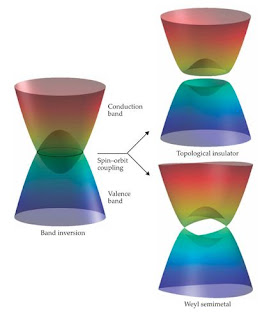Topics: Modern Physics, Particle Physics, Quantum Mechanics
When Paul Dirac introduced his famous equation for relativistic fermions in 1928, he aimed to describe one well-known particle: the electron. Shortly thereafter, Hermann Weyl observed that the equation has a special solution when the mass is set to zero. The so-called Weyl fermions embodied by that solution would be charged, like electrons, but being massless, they would travel faster and with less energy dissipation. The particles would also be chiral, like neutrinos, with each one’s handedness depending on whether its spin is aligned or antialigned with its momentum. Those features make Weyl fermions appealing candidates for use in electronic and spintronic devices.
No such elementary particle has yet been found. However, in 2015 three groups of researchers identified the first Weyl semimetal (WSM), tantalum arsenide, which hosts quasiparticles—collective excitations of electrons—with the properties of Weyl fermions.1 A WSM must have a broken symmetry, and in TaAs, it’s inversion symmetry. Researchers, however, have continued searching for materials, particularly ferromagnetic materials, that instead rely on broken time-reversal symmetry. Tying a WSM crystal’s properties to magnetism, which can be adjusted using temperature changes or external fields, makes them potentially tunable.
Three new papers provide experimental evidence for magnetic WSMs. Yulin Chen’s team at Oxford University and Haim Beidenkopf’s team at the Weizmann Institute of Science, together with collaborators,2 presented studies of Co3Sn2S2, and Zahid Hasan’s group at Princeton University3 looked at Co2MnGa. The works identify important features in the electronic structures of both materials’ bulk and surface states.
Magnetic semimetals host massless quasiparticles, Christine Middleton, Physics Today
#P4TC: Weyl Fermions...July 27, 2015

Comments